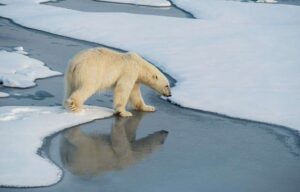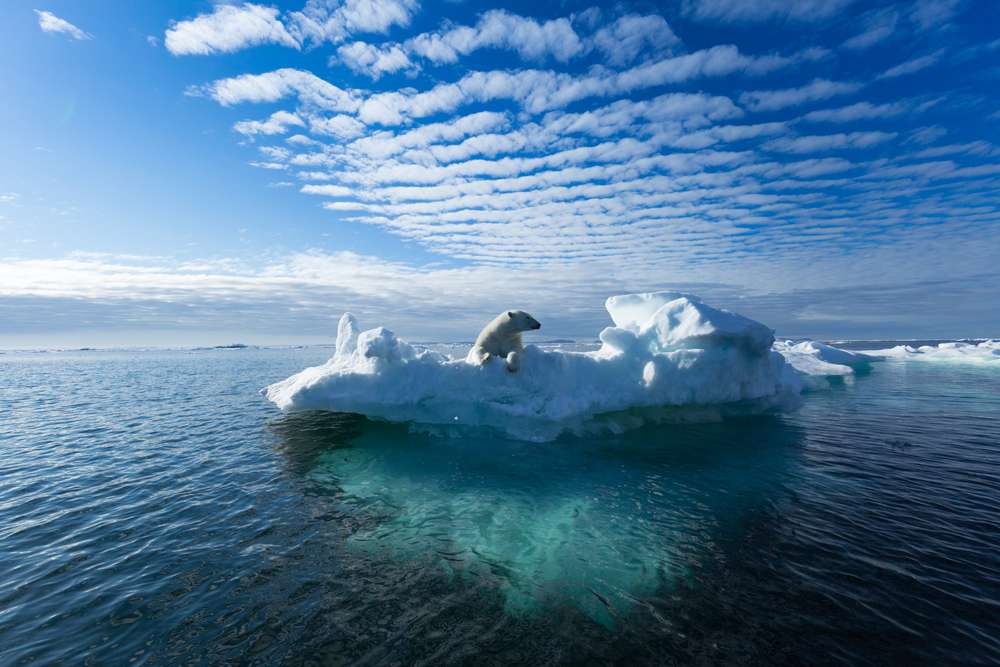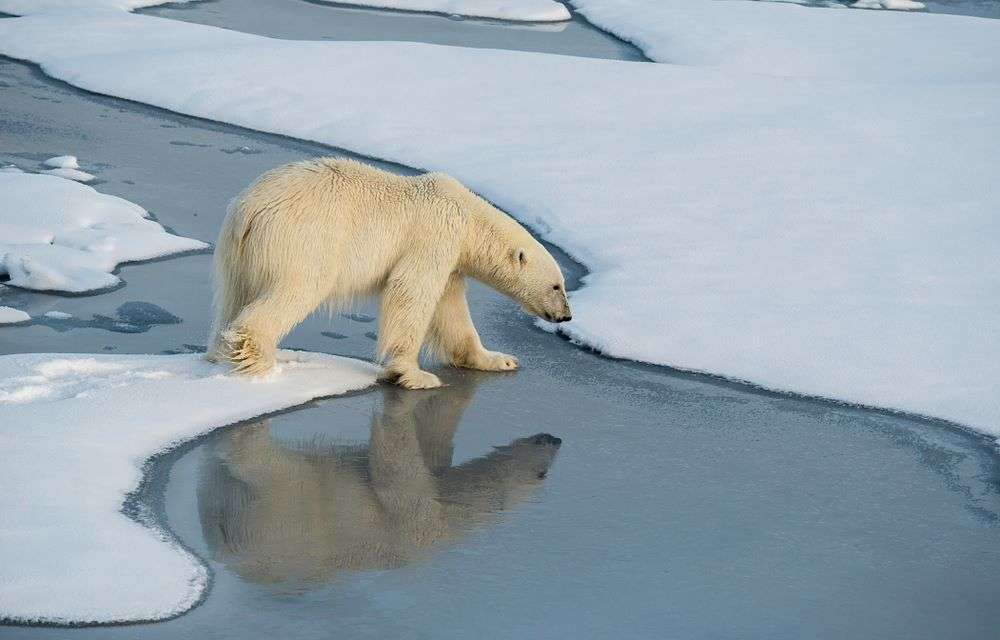Introduction: The Plight of Polar Bears in a Changing Arctic

When one envisions polar bears, images of majestic creatures navigating vast expanses of ice come to mind. However, the reality is a far cry from this picturesque scene. In today’s rapidly changing Arctic landscape, polar bears face unprecedented challenges due to the melting of their sea ice habitat. The consequences of climate change are pushing these magnificent creatures into closer proximity to human communities, requiring urgent and innovative solutions.
The Arctic, once a remote and inhospitable expanse, is now a region witnessing profound transformations. The warming temperatures are accelerating the melting of sea ice, disrupting the delicate balance that polar bears have maintained for centuries. These apex predators rely on the frozen expanses of the Arctic Ocean for hunting seals, their primary food source. As the ice diminishes, polar bears are compelled to travel longer distances, expend more energy in search of food, and increasingly navigate areas inhabited by humans. This shift in their behavior not only poses risks to the bears but also raises concerns about potential conflicts with human populations. The urgency to address this situation has led to the exploration of cutting-edge technologies and innovative strategies aimed at fostering coexistence between polar bears and human communities.
Technology for Polar Bear Conservation
In the quest for coexistence between polar bears and humans, modern technology emerges as a beacon of hope. Among the cutting-edge innovations is the AI-powered “Bear-dar” radar system. Acting as an early-warning mechanism, this technology utilizes artificial intelligence to detect polar bear movements, providing crucial alerts to communities to avoid unexpected encounters. Simultaneously, satellite-tracking devices, whimsically named “Burr on fur,” offer real-time monitoring of bear movements, empowering researchers and communities to stay informed about their locations and activities.
In addition to tracking, a range of deterrents is being explored to discourage polar bears from venturing too close to human settlements. These non-lethal methods, including sounds, strobe lights, scents, and electrified door mats, aim to create an environment where polar bears perceive potential risks, fostering a harmonious coexistence.
Impact of Climate Change on Polar Bear Behavior
The undeniable link between climate change and the altered behavior of polar bears underscores the urgency of developing effective coexistence strategies. As the Arctic climate undergoes significant shifts, the loss of sea ice forces polar bears to seek food and suitable conditions closer to human-inhabited areas. The warming climate contributes to melting Arctic ice, disrupting the bears’ natural habitat and increasing the likelihood of encounters with human communities.
Rare Attacks: Understanding the Dynamics
While the increasing proximity of polar bears to human settlements raises concerns, instances of fatal attacks are remarkably rare. Polar bears, by nature, are not predisposed to view humans as prey. Fatal interactions are often a result of specific circumstances rather than predatory behavior. Recognizing this rarity emphasizes the importance of prioritizing non-lethal coexistence strategies. Efforts to understand the factors contributing to rare attacks inform the design of effective deterrents and education programs.
This nuanced understanding underscores the potential for peaceful coexistence between polar bears and human communities. By addressing the root causes of conflicts and implementing proactive measures, it is possible to minimize the risks associated with human-bear interactions. Through community engagement, education, and the development of advanced technologies, we can create environments where both species thrive without compromising safety.
The Urgency for Coexistence Strategies: Adapting to a Changing Landscape
The rapidly changing Arctic landscape demands immediate action in developing and testing coexistence strategies between polar bears and humans. With sea ice shrinking due to warming temperatures, polar bears venture closer to communities, requiring swift adaptation to address the challenges posed by their increasing proximity. The urgency for coexistence strategies arises from the accelerated pace of environmental changes, necessitating measures to ensure the safety of both polar bears and human communities.
While the increasing proximity of polar bears to human settlements raises concerns, instances of fatal attacks are remarkably rare. Polar bears, by nature, are not predisposed to view humans as prey. Fatal interactions are often a result of specific circumstances rather than predatory behavior. Recognizing this rarity emphasizes the importance of prioritizing non-lethal coexistence strategies. Efforts to understand the factors contributing to rare attacks inform the design of effective deterrents and education programs.
This nuanced understanding underscores the potential for peaceful coexistence between polar bears and human communities. By addressing the root causes of conflicts and implementing proactive measures, it is possible to minimize the risks associated with human-bear interactions. Through community engagement, education, and the development of advanced technologies, we can create environments where both species thrive without compromising safety.
Challenges and Opportunities: Balancing Conservation with Human Activities
The call to action resonates not only in the Arctic but echoes globally, emphasizing the need for sustainable practices and responsible stewardship of our planet. The intricate dance between human progress and environmental preservation requires a delicate balance, where technology, policy, and community engagement converge. By fostering a collective commitment to responsible practices, there is potential for creating a world where ecological harmony and human activities coexist synergistically.
In the face of climate change, it becomes imperative to view challenges as catalysts for positive change. Collaborative efforts can transform obstacles into stepping stones, ensuring that the delicate ecosystems, including those inhabited by polar bears, are preserved for future generations. This journey demands a holistic approach, where each stakeholder plays a crucial role in shaping a sustainable and harmonious future for our planet.
Conclusion: A Call for Swift and Holistic Action
In conclusion, modern technology stands at the forefront of efforts to safeguard polar bears and promote coexistence with human communities in the face of climate change. The urgency for action cannot be overstated, and by embracing innovative solutions, there is hope for a future where polar bears and humans share a harmonious and sustainable relationship in the Arctic. It is a call for swift and holistic action to secure the well-being of these magnificent creatures and the communities they navigate in this evolving environmental landscape.
As we navigate the complexities of climate change, the intersection between technological advancements and environmental conservation becomes paramount. The AI-powered systems, satellite tracking devices, and non-lethal deterrents showcase the potential of human ingenuity to address challenges created by the changing Arctic conditions. This moment in history calls for a collective commitment to preserving the Arctic ecosystem, recognizing that the well-being of polar bears is intertwined with the health of our planet. The evolving relationship between polar bears and humans serves as a poignant reminder of our responsibility to adapt, innovate, and coexist harmoniously in the face of environmental transformations.

